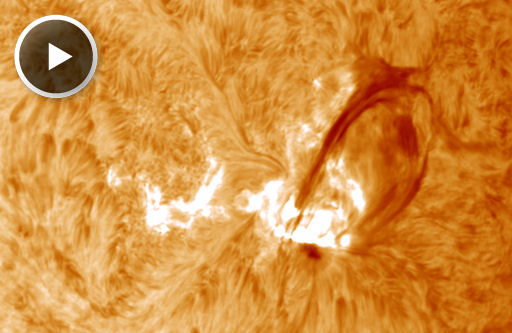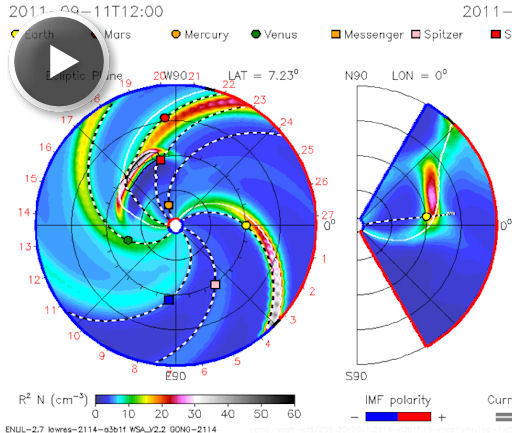Solar wind
speed: 430.3 km/sec
density: 1.5 protons/cm3
explanation | more data
Updated: Today at 1654 UT
X-ray Solar Flares
6-hr max: M1 1249 UT Sep09 [ ANOTHER FLARE THIS MORNING M CLASS]
24-hr: M7 1552 UT Sep08
explanation | more data
Updated: Today at: 1700 UT
![]()
Daily Sun: 09 Sep 11
Sunspot 1283 has a "beta-gamma-delta" magnetic field that harbors energy for X-class solar flares. Credit: SDO/HMI
GEOMAGNETIC STORM: A polar geomagnetic storm (Kp=5) is in progress following the impact of a CME around 1100 UT on Sept. 9th. This could be the first of several hits from a series of CMEs expected to reach Earth during the weekend. High-latitude sky watchers should be alert for auroras after nightfall. Aurora alerts: text, voice.
Update: Electrical ground currents caused by the storm have been detected in Norway.
ACTIVE SUNSPOT: Sunspot 1283 is producing flares so intense they are visible through solar telescopes in backyards 93 million miles away. Amateur astronomer Andy Devey photographed this one, and M6-class eruption, from Barnsley UK on Sept. 8th:
The magnetic canopy of sunspot 1283 has an unstable "beta-gamma-delta" configuration tthat harbors energy for more powerful eruptions. NOAA forecasters estimate a 75% chance of M-flares and a 25% chance of X-flares during the next 24 hours. Solar flare alerts: text, voice.
more images: from Bob Yoesle of Goldendale, Washington; from Sergio Castillo of Inglewood, California; from Monty Leventhal OAM of Sydney, Australia; from James Kevin Ty of Manila, Philippines; from Alcaria Rego of Almada, Portugal
MERCURY-DIRECTED CME: On Sept 8th around 2300 UT, the SOHO and STEREO spacecraft detected a significant CME emerging from the farside of the sun. Earth is not in the line of fire, but the planet Mercury is. Analysts at the Goddard Space Weather Lab estimate that the cloud will reach the innermost planet on Sept. 9th at 12:00 UT (plus minus 7 hours). Click to view a movie of their CME model:
NASA's MESSENGER spacecraft is in orbit around Mercury, so it will have a front row seat for the impact. Researchers are keen to learn how Mercury's magnetosphere responds to CMEs. In particular, they wonder if CMEs can overpower Mercury's magnetic field and sputter atoms right off the planet's surface. Thanks to the Goddard forecast, MESSENGER's controllers know the CME is coming, and they can prepare to observe the impact.
Interplanetary space weather forecasting is a new thing. It became possible in 2010-2011 when NASA and ESA spacecraft surrounded the sun. Working together, SOHO, the Solar Dynamics Observatory, STEREO-A and STEREO-B now have the entire star under surveillance. CMEs can be tracked no matter where they go, which means space weather isn't just for Earth anymore.




